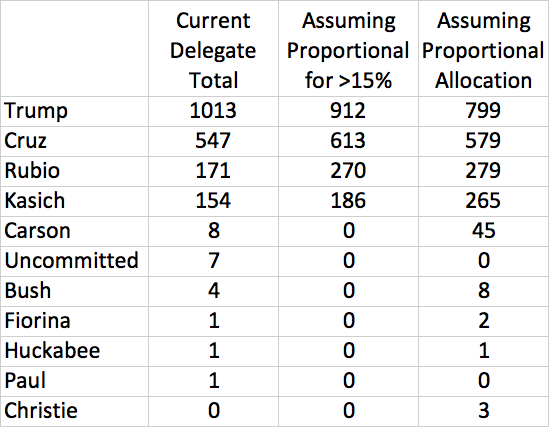After yesterday’s primary in Indiana, both Ted Cruz and John Kasich have dropped out of the race, leaving Donald Trump as the presumptive nominee for the Republican party. This was disappointing to those of us who were hoping for some contested-convention drama, but sensible, since Trump is now virtually certain to go into the convention with the 1237 pledged delegates required to secure the nomination on the first ballot.
At various points during this primary season, I’ve calculated what the delegate counts would have been under alternative allocation schemes. The Republican party uses a process that varies from state to state. In general, the early states tend to allocate delegates more proportionally among candidates, while later states tend to be more winner-take-all. By contrast, the Democratic party uses a uniform method: proportional allocation among the candidates receiving more than 15% of the vote (applied both at the state and congressional-district levels).
Under the actual scheme, Trump currently has about 1013 pledged delegates (plus, possibly, some supporters among the formally unpledged delegates from Pennsylvania). He only needs to win about half of the remaining 445 delegates to reach the threshold, and he would be almost certain to do so, even if Cruz and Kasich stayed in the race.
However, if the Republicans used the Democratic scheme (applied only at the state level, for simplicity), Trump would have 912 pledged delegates, and would need 73% of the remaining delegates to prevent a contested convention. Under proportional allocation with no threshold, he would have 799 delegates, and would need to win over 98% of the remaining delegates.
One consequence of (and perhaps rationale for) using winner-take-all allocation in a drawn-out primary season is that it drives out challengers, forcing consensus around the leading candidate and allowing them to begin their general-election pivot earlier.
Another consequence is that a pesky plurality of “voters” can drive the nomination of an openly bigoted narcissist, subverting the ability of the party elite to install one of the usual cryptically bigoted narcissists. That’s a consequence that will either be hilarious to Democrats in November or hilarious to extraterrestrial archaeologists who visit the smoldering remains of our planet thousands of years in the future.
Methodological notes:
- For these projections, I used some made-up numbers for the Virgin Islands, Colorado, and Wyoming, which have 75 delegates among them, but did not hold popular votes. For the proportional allocation numbers (with and without thresholding), I gave Trump 36 of those, Cruz 25, and Kasich 14. You could argue for different made-up numbers, but it would not alter the basic story.
- I quit assigning delegates to candidates after they suspended their campaigns. In certain states, due to early voting, under a strictly proportional allocation scheme, some candidates would have earned a few delegates after quitting the race. More significantly — but even harder to control for — under a different allocation scheme, candidates would have made different decisions about whether/when to drop out, how/where to spend their time and money, and so on.
